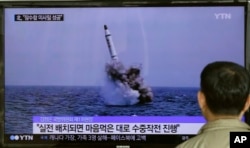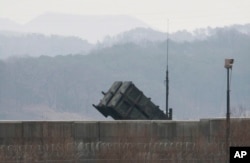North Korea test fired three ballistic missiles on Tuesday, a week after it threatened to retaliate against South Korea over the deployment of the THAAD missile defense system.
Both the U.S. and South Korea said the missiles Pyongyang launched early on Tuesday were likely medium range Scud or Rodong types that flew between 500 and 600 kilometers before falling into the sea off the east coast of the Korean peninsula.
Tokyo denounced North Korea’s multiple missile launch and said it would strengthen cooperation with the U.S. and South Korea to deal with the continuing threat.
"We urge strongly that North Korea restrain from further [missile] activities, and will take all possible measures to deal with any situation [which may arise], said Japanese Defense Minister Gen Nakatani.
The North American Aerospace Defense Command (NORAD) determined the missile launches from North Korea did not pose a threat to North America.
Intimidation tactic
The U.S. and South Korea recently agreed to deploy the Terminal High Altitude Area Defense (THAAD) defense system to defend against the North’s increasing nuclear and missile capabilities.
North Korea on July 11 responded by threatening to launch a retaliatory strike against the THAAD deployment by turning the South “into a sea of fire and a pile of ashes.”
Jeon Ha-gyu, the Joint Chiefs of Staff spokesman for the South Korean military, said Tuesday’s missile launches were meant to further intimidate.
“Our assessment is that this was done as a show of force. The range of the ballistic missiles fired today is enough to hit the entire area of South Korea including Busan as a target," said Jeon.
Following its fourth nuclear test in January, North Korea has conducted numerous ballistic missile launches, often to test technological advancements made to increase the range and accuracy of the missiles.
But the Scud and Rodong missiles test fired on Tuesday are based on old Soviet designs that are considered “entry level” ballistic missiles and inaccurate weapons that do not use sophisticated technology.
“This (missile launch) was not to advance any technological capability. The missiles North Korea has fired in the past are almost same as the ones it fired today,” said Professor Kim Dong-yeop, a military analyst at Kyungnam University in South Korea.
THAAD discontent
The North Korean missile launch may have also been, in part, an attempt to increase public anxiety over THAAD in South Korea.
Joshua Pollack, editor of the U.S.-based Nonproliferation Review, said Tuesday's launches, “might be a way of reminding their southern neighbors that the site chosen for a THAAD battery in South Korea is within reach".
Citing concerns over public health and safety, THAAD opponents in South Korea have staged mass demonstrations and are organizing petition drives to force the government to reverse its decision to deploy the controversial missile defense system.
Most of the protests have occurred in Seongju County, near the site where THAAD is to be deployed in the southeastern part of the country.
Many local residents worry that locating THAAD near their communities will make them targets for North Korean retaliatory strikes.
THAAD uses high-resolution radar designed to detect and track ballistic missile threats at long distances and high altitudes.
There is also concern that exposure to electromagnetic radiation from the system’s radar could cause serious harm to nearby residents and could contaminate agricultural products.
This week, U.S. military officials invited South Korean journalists to Guam to inspect the THAAD battery in place there and address their concerns.
Last week the South Korean military brought journalists to a Patriot missile defense site south of Seoul that uses the same model radar.
Officials measured the system’s electromagnetic emissions and said they fell within safety standards and reassured the public that the THAAD site will be placed 1.5 kilometers away from the nearest population center.
China
China supported the strong United Nations sanctions imposed on North Korea for its nuclear test this year, and has called on Pyongyang to end its banned nuclear and missiles tests.
But Beijing also opposes the THAAD deployment and there is concern that Beijing may take economic measures to retaliate against South Korea.
Analysts say Beijing is concerned in particular about THAAD’s radar capability to monitor Chinese military installations and in general about Washington’s increasing military strength in the region.
Youmi Kim and Han Sang-mi in Seoul contributed to this report.













